Abstract
Lactic acid bacteria (LAB) play an important role as natural food preservatives. However, the characterization of the variety of their metabolites is limited. The objective of this study was to determine the production of specific metabolites of Lacticaseibacillus rhamnosus, Levilactobacillus brevis and Lactiplantibacillus plantarum by an optimized liquid chromatography with an ultraviolet/diode detection (HPLC-UV/DAD) method and to investigate their potential antimicrobial activity against specific food pathogens. Based on the results of this study, the main metabolites detected in Levilactobacillus brevis were 103.4 μg mL−1 DL-p-Hydroxyphenyllactic acid (OH-PLA) and 2.59 μg mL−1 vanillic acid, while 216.2 μg mL−1 OH-PLA, 19.0 μg mL−1 salicylic acid, 3.7 μg mL−1 vanillic acid, 6.9 μg mL−1 ferulic acid, 4.2 μg mL−1 benzoic acid and 1.4 μg mL−1 4-Hydrocinnamic acid were identified in the Lactiplantibacillus plantarum strain and 147.6 μg mL−1 OH-PLA and 4.9 μg mL−1 ferulic acid were identified in Lacticaseibacillus rhamnosus. This study provides alternative approaches for the molecules involved in the antimicrobial activity of food microorganism fermentation. These molecules may be used as antimicrobial ingredients in the food industry instead of conventional chemical preservatives.
1. Introduction
Innovative approaches and new data are created in the food technology sector for the quality improvement and safety assurance of produced foods. To date, the complete genomes of several probiotic LAB species have been sequenced and reported in the literature [1,2,3]. This information has notably facilitated an explanation of the functionality and technological attributes of these species. The current trend of reducing the consumption of ‘processed’ food has resulted in the replacement of conventional processing methods with alternatives, including the incorporation of microorganisms such as lactic acid bacteria (LAB) and antimicrobial compounds such as bacteriocins produced in food matrices [4,5,6,7,8,9].
LAB biopreservation is an alternative way to replace chemical preservatives in food. It is widely studied because of the role and the long history of the application of LAB in fermented foods [10,11,12,13,14]. The use of LAB and their metabolic products is an effective way to extend the shelf life and safety of a food. In this way, the action of spoilage and pathogenic microorganisms are inhibited, without modifying the desired organoleptic characteristics and nutritional value of the food [15,16,17,18,19].
Probiotics are live microorganisms that, when administered in adequate quantities, confer beneficial effects on human health by regulating the microbial balance in the gastrointestinal tract [20]. These bacteria prevent gastrointestinal illness by enhancing the growth of beneficial microorganisms and by inhibiting the multiplication mechanisms of pathogens [21,22].
The aim of this study was to determine specific metabolites produced by Lacticaseibacillus rhamnosus, Levilactobacillus brevis and Lactiplantibacillus plantarum and to investigate their potential antimicrobial activity against common food pathogens. Considering that LAB exhibit similar effects in vitro and the fact that their metabolites may target and play a role in the competitive exclusion of pathogens, the present study aimed to screen bacteria that produce numerous antimicrobial peptides and acids that may be effective biopreservatives for food products.
2. Materials and Methods
2.1. Bacterial Cultures
Lacticaseibacillus rhamnosus GG ATCC53103, Levilactobacillus brevis ATCC8287 and Lactiplantibacillus plantarum ATCC14917 (LAB) were grown in MRS broth (De Man Rogosa Sharp) and incubated at 37 °C for 48 h under anaerobic conditions prior to each experiment. The stock cultures were kept at −80 °C in MRS broth containing 20% (v/v) sterile glycerol.
2.2. Pathogenic Microorganisms
The pathogenic microbial species Salmonella enterica ATCC14028, Staphylococcus aureus ATCC 29213, Escherichia coli ATCC 25922 and Klebsiella pneumoniae ATCC 700603 were used in order to study the antimicrobial activity of the metabolites of the selected lactic acid bacteria.
2.3. Preparation of Standards
The standard solutions (Table 1) were prepared at known concentrations (100 ppm) in 90/10 (H2O/Methanol). The calibration curve standards were prepared at 1, 5, 10, 15 and 20 ppm and stored in vials (1.5 mL) supplemented with 90/10 (H2O/Methanol). The selection of the standard compounds was based on literature [23,24,25,26].

Table 1.
Maximum absorbance (λmax) of 14 standard compounds determined by HPLC-UV/DAD.
2.4. Extraction Procedures
The LAB strains were grown in MRS broth at 37 °C for 48 h under anaerobic conditions. The broths were centrifuged at 13,000× g for 7 min and the supernatants were filtered (filter pore size 0.22 μm) to prepare cell-free supernatants (CFSs). A non-inoculated MRS broth medium (no bacteria added) was used as a blank matrix (negative control).
2.5. Liquid Liquid Extraction (LLE)
Ten milliliters CFSs were added to 10 mL ethyl acetate, 1 g NaCl and 4 g Na2SO4 in 50 mL conical tubes and centrifuged at 4000× g for 10 min. Subsequently, 5 mL of the organic phase was collected by adding 100 μL of dimethyl sulfoxide (DMSO) and dried in a rotary evaporator. The dry phase was reconstituted (90% water and 10% methanol). The samples were filtered (0.22 μm) and aliquoted in two different vials. The 14 standards of known concentration were added in the first aliquot as internal controls in order to exactly identify the retention time and the wavelength of each peak. Both aliquots (with and without the internal controls, respectively) were analyzed by HPLC-UV/DAD. The optimum separation conditions are described below. A blank MRS broth was treated accordingly [23,24,25,26].
2.6. Instrumentation and Analytical Conditions
2.6.1. Chromatographic Conditions (HPLC-UV/DAD)
A Hitachi LaChrom Elite HPLC system with diode array detector (L-2455) achieved separation of standard compounds on an SVEA C18 Gold column (150 × 4.6 mm 5 µm, Sweden). The column was maintained at 30 °C. The injection volume was 20 μL and λmax = 280 nm with a λ range of 210–325 nm. Elution was performed using a gradient flow from water containing 0.1% formic acid (solvent A) and methanol containing 0.1% formic acid (solvent B). Initial conditions were optimized (10% for 0 min (B); 30% for 10 min (B); 40% for 20 min (B); 40% for 25 min (B); 100% for 40 min (B); 100% for 45 min (B); 90% for 50 min (B); 10% for 55 min (B)) at a flow rate of 0.500 mL/min−1 [24].
2.6.2. Precision of Standard Calibration Curves
Linear calibration curves were determined by generating a standard curve, in which serial 2-fold dilutions of standards were analyzed. The standard curve was generated by plotting the absorbance of each dilution against the known concentrations of standards. The resulting slope showed a linear relationship over 5 orders of magnitude, ranging from 1.25 to 20 mg/mL with a correlation coefficient R2 > 0.99. The detection rate was 100% for up to 1 mg/mL.
2.7. Antimicrobial Activity Assay
Four standardized ATCC strains from laboratory stock cultures were used in the evaluation of the antimicrobial activity of the CFSs, i.e., Salmonella enterica ATCC14028, Staphylococcus aureus ATCC 29213, Escherichia coli ATCC 25922 and Klebsiella pneumoniae ATCC 700603. Testing media (Selective Chromoagar for each pathogen) and Mueller–Hinton Agar (MHA) were used in order to evaluate the antimicrobial activity. The antimicrobial activity of CFSs filtrate was determined against the pathogen’s organisms. The CFSs incubated for 30 days at 37 °C. Fifty microliters of the incubated CFSs was removed on different days in order to find the best antimicrobial activity. One hundred microliters of microbial culture of an approximate inoculums size of 1.0 × 108 CFU/mL was added to all wells. Fifty microliters of the CFSs, on different days of incubation, were loaded into the microtiter plate containing each of the tested microbial strains. The plate was then incubated at 37 °C for 24 h. The lowest effective dose of each selected supernatant, which still significantly inhibited the growth of target pathogens, was determined as described in Table 4. The antimicrobial activity was confirmed using selective agar plates for each pathogen, as shown in Figure 1, Figure 2, Figure 3 and Figure 4. All measurements were performed in triplicate [27].
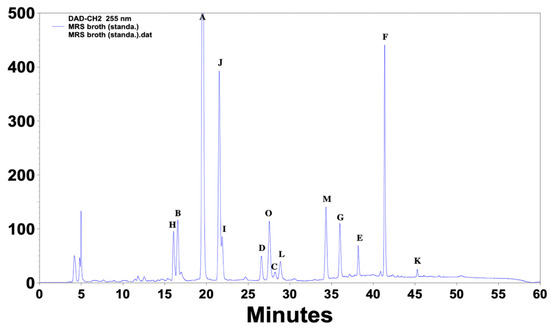
Figure 1.
Chromatogram at 255 nm of 14 standard mixes (50 ppm; 10 mL injection) of previously reported antifungal compounds from LAB prepared in water–methanol (90/10) and MRS broth (filtered 0.22 μm; LLE extraction; 20 μL direct injection). (A) 4-hydroxybenzoic acid (19.3 min); (B) DL-p-Hydroxyphenyllactic acid (16.3 min); (C) Phenyllactic acid (28 min); (D) 3-(4-Hydroxyphenyl) propionic acid (26.4 min); (E) Hydrocinnamic acid (38 min); (F) Methylcinnamic acid (41.3 min); (G) Salicylic acid (36 min); (H) 1,2-Dihydroxybenzene (15.7 min); (I) 3,4-Dihydrocinnamic acid (21.7 min); (J) Vanillic acid (21.3 min); (K) 3,4-Dihydroxyhydrocinnamic acid (45.3 min); (L) Ferulic acid (28.7 min); (M) salicylic acid (34.2 min); (O) 4-Hydrocinnamic acid (27.4 min).
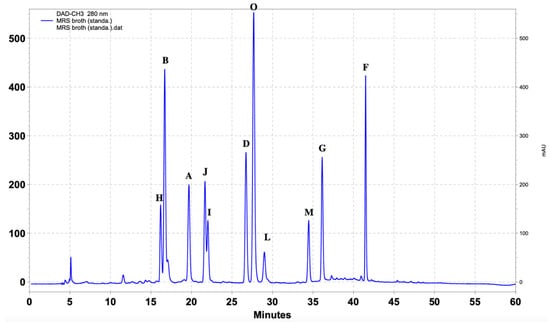
Figure 2.
Chromatogram at 280 nm of 11 standard mixes (50 ppm; 10 mL injection) of previously reported antifungal compounds from LAB prepared in water–methanol (90/10) and MRS broth (filtered 0.22 μm; LLE extraction; 20 μL direct injection). (A) 4-hydroxybenzoic acid (19.3 min); (B) DL-p-Hydroxyphenyllactic acid (16.3 min); (D) 3-(4-Hydroxyphenyl) propionic acid (26.4 min); (F) Methylcinnamic acid (41.3 min); (G) Salicylic acid (36 min); (H) 1,2-Dihydroxybenzene (15.7 min); (I) 3,4-Dihydrocinnamic acid (21.7 min); (J) Vanillic acid (21.3 min); (L) Ferulic acid (28.7 min); (M) salicylic acid (34.2 min); (O) 4-Hydrocinnamic acid (27.4 min).
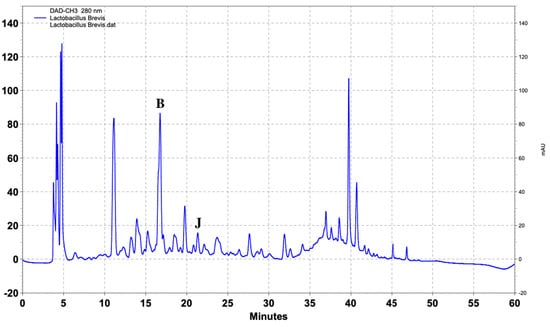
Figure 3.
Chromatographic profile of Levilactobacillus brevis ATCC8287 showing antimicrobial activity. High mass accuracy spectrum of compound (B) OH-PLA (16.3 min); high mass accuracy spectrum of compound (J) Vanillic acid (21.3 min).
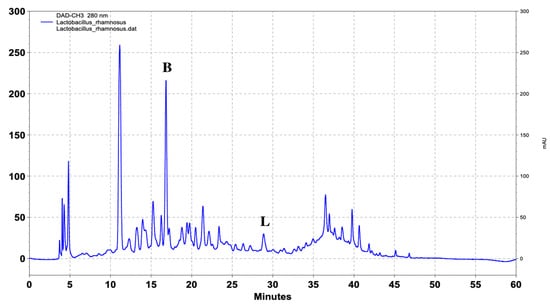
Figure 4.
Chromatographic profile of Lacticaseibacillus rhamnosus GG ATCC53103 showing antimicrobial activity. High mass accuracy spectrum of compound (B) OH-PLA (16.3 min); high mass accuracy spectrum of compound (L) Ferulic acid (28.7 min).
3. Results and Discussion
Lactic acid bacteria occur naturally in various foodstuffs; either their growth is enhanced, or they are added deliberately to produce a range of fermented foods. These include fish, meat, various dairy products, cereals, fruits and vegetables, including legumes. This important group of starter cultures is used in the production of a wide range of fermented foods; they contribute to the enhancement of the characteristics of food, and they have been recognized as contributing to the microbial safety of fermented food [6,8]. LAB have an important antimicrobial function due to their production of certain metabolites, such as organic acids [28,29,30,31,32]. Certain strains of L. plantarum from sourdough have been reported to produce 3-(4-hydroxyphenyl)lactic acid (HPLA) and PLA and have been reported to be antifungal compounds. Many reports have suggested that antifungal activity is a combination of organic acids such as lactic, acetic, phenyllactic acids or bacteriocins and low-molecular-weight antimicrobial agents and peptides [26,33].
The objective of this study was to optimize the HPLC-UV/DAD method for the qualitative and quantitative determination of 14 different LAB metabolites. Sample preparation (extraction and clean-up) is a prerequisite for analyzing the majority of food matrices, and in the area of LAB, this process is appropriate. The high accuracy, the time and the cost of our method in this article were the same compared to an earlier study undertaken by Brosnan [23,24]. According to Brosnan et al., 2014, HPLC-UV/DAD, GC-MS and LC-MS were used to identify LAB-producing compounds. These methods allow the compounds to be determined in a single chromatographic test. Τhe retention time of these methods is about 40 min. Elution was performed using a gradient flow of water containing formic acid (solvent A) and acetonitrile containing formic acid (solvent Β). The cost of analysis for all methods mentioned above is the same price for every single run. The solvents are quite economical, but the standards compounds are expensive.
The identification of standards, the wavelengths and the retention time of each compound are shown in Table 1. The response intensity and retention time of the chromatographic peaks from the three analyses almost overlap, which shows limited variations due to instrument errors.
The chromatographic method was optimized for the quantitative analysis of 14 compounds in LAB strains within a run period of 60 min. Based on the results, the three standards (phenyllactic acid (28 min); hydrocinnamic acid (38 min); 3,4-Dihydroxyhydrocinnamic acid (45.3 min)) were identified at 255 nm (Figure 1 and Figure 2). Compared to phenyllactic acid and 3,4-dihydroxyhydrocinnamic acid, all the tested standards showed higher absorbance at 255 nm.
The main metabolites that were detected in the tested LAB strains are presented in Table 2. Lactiplantibacillus plantarum was a unique strain that produced all six detected metabolites (Figure 3, Figure 4 and Figure 5). DL-p-Hydroxyphenyllactic acid (OH-PLA) was identified in the metabolites of three of the tested LAB. The highest concentration (217.8 ppm) was found in Lactiplantibacillus plantarum and the lowest (103.4 ppm) in Levilactobacillus brevis (Table 2). A similar quantity of vanillic acid range (2.6–3.4 ppm) was identified in Levilactobacillus brevis and Lactiplantibacillus plantarum, respectively. Ferulic acid was isolated in different concentrations in Lacticaseibacillus rhamnosus and Lactiplantibacillus plantarum ranged from 4.9 to 6.4 (Table 2).

Table 2.
Concentration (in ppm) of the 14 tested compounds determined in Levilactobacillus brevis, Lactiplantibacillus plantarum and Lacticaseibacillus rhamnosus cultures.
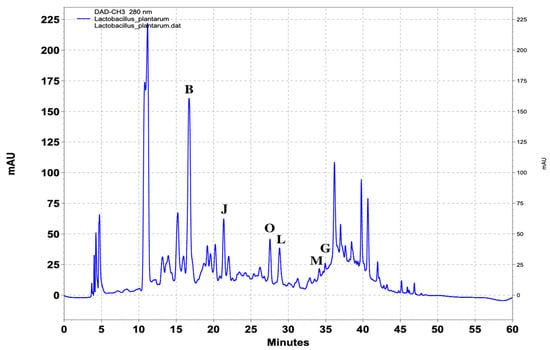
Figure 5.
Chromatographic profile of Lactiplantibacillus plantarum ATCC14917 showing antimicrobial activity. High mass accuracy spectrum of compound (B) OH-PLA (16.3 min); high mass accuracy spectrum of compound (J) Vanillic acid (21.3 min); high mass accuracy spectrum of compound (O) 4-Hydrocinnamic acid (27.4 min); high mass accuracy spectrum of compound (L) Ferulic acid (28.7 min); high mass accuracy spectrum of compound (M) Benzoic acid (34.2 min); high mass accuracy spectrum of compound (G) Salicylic acid (36 min).
It was observed that the metabolites produced by the tested LAB species in the broth medium remained the same over a period of 30 days while the concentrations increased in the broth (Table 3). Thus, metabolites could be identified from the first day of incubation of the microorganism. None of these compounds was detected in the blank MRS broth.

Table 3.
Concentration (in ppm) of metabolites produced by Levilactobacillus brevis, Lactiplantibacillus plantarum and Lacticaseibacillus rhamnosus.
The analysis was implemented during a 30 day period. The concentration of each metabolite was determined at a 5 day interval, as shown in Table 3. In the present study, the concentration of metabolites increased until the 10th day. Afterward, the metabolites’ concentrations followed a stable pattern [27].
Axel [28] et al., (2015), investigated the antifungal activity of L. reuteri R29 and the production of antifungal carboxylic acids in wheat sourdough. The results of the study showed that L. brevis R2D produced ferulic acid (22 mg/mL), salicylic acid (1 mg/mL), vanillic acid (8 mg/mL) and 3-phenylacetic acid (8 mg/mL). Brosnan et al. (2014), studied the case of Lactiplantibacillus plantarum for the potential production of antimicrobial compounds. The results showed that the metabolic compounds identified in L. plantarum were 4.8 mg/mL of OH-PLA, 1.03 mg/mL of 4-hydroxybenzoic acid, 0.04 mg/mL of caffeic acid, 43 mg/mL of phenyllactic acid, 0.46 mg/mL of coumaric acid, 0.13 mg/mL of 3-(4-hydroxy-3-methoxyphenyl) propanoic acid, 0.29 mg/mL of benzoic acid and 1.2 mg/mL of ferulic acid.
The present study investigated the antimicrobial activity of the obtained CFSs after 30 days incubation of the three LAB strains against pathogenic microbial species (Salmonella enterica ATCC14028; Staphylococcus aureus ATCC 29213; Escherichia coli ATCC 25922; Klebsiella pneumoniae ATCC 700603).
The inhibition of active antimicrobial substances produced by different LAB species after incubation at 37 °C and against pathogens appeared to be similar, as shown in Table 4 and in Figure 6, Figure 7, Figure 8 and Figure 9. All obtained CFSs from LAB cultures showed significant inhibitory effects on the tested Gram-negative and -positive pathogens. The isolated LAB inhibited the growth of the tested pathogenic strains successfully, indicating that the addition of LAB strains in commercial food products may provide effective protection against infections caused by specific pathogens. All the metabolites produced from the three LAB species that were incubated for 5 days at 37 °C inhibited all the pathogen microorganisms. The potential application of LAB for the control of the proliferation of undesirable microorganisms has been reported for different food products of plant or animal origin [29,30,31].

Table 4.
The inhibition of pathogens’ growth by active antimicrobial substances produced by Levilactobacillus brevis, Lactiplantibacillus plantarum and Lacticaseibacillus rhamnosus.
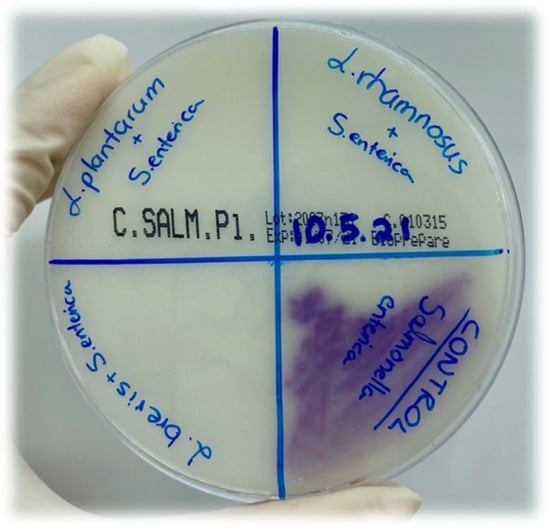
Figure 6.
The results of the antimicrobial activity of CFCs (after 5 days incubation) of three LAB species (Levilactobacillus brevis, Lactiplantibacillus plantarum, Lacticaseibacillus rhamnosus) against pathogenic bacteria Salmonella enterica ATCC14028.
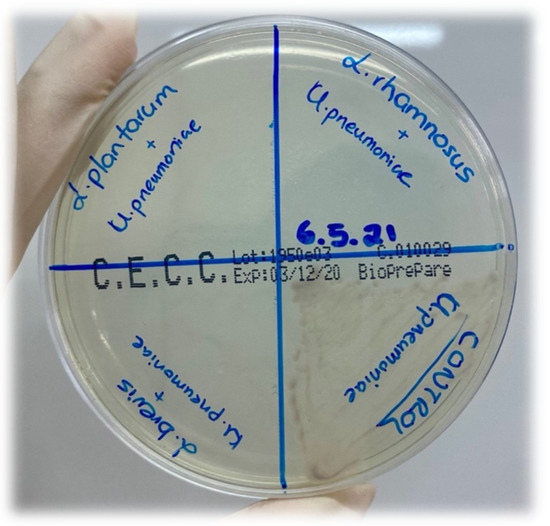
Figure 7.
The results of the antimicrobial activity of CFCs (after 5 days incubation) of three LAB species (Levilactobacillus brevis, Lactiplantibacillus plantarum, Lacticaseibacillus rhamnosus) against pathogenic bacteria Kl. Pneumoniae ATCC700603.
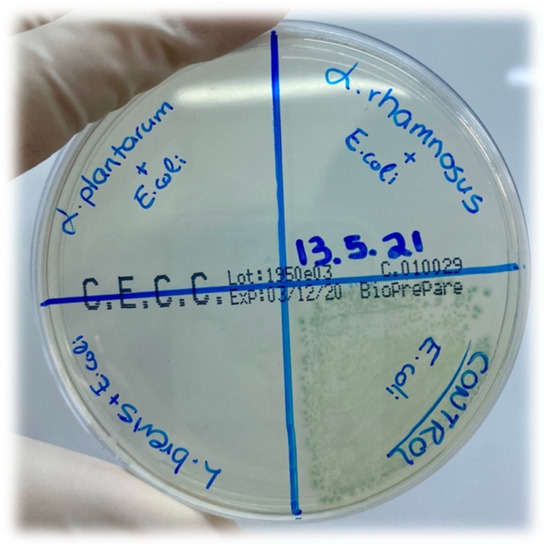
Figure 8.
The results of the antimicrobial activity of CFCs (after 5 days incubation) of three LAB species (Levilactobacillus brevis, Lactiplantibacillus plantarum, Lacticaseibacillus rhamnosus) against pathogenic bacteria E. coli ATCC 25922.
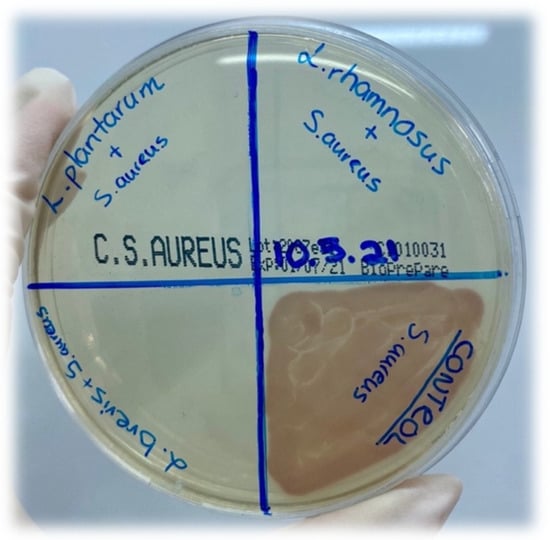
Figure 9.
The results of the antimicrobial activity of CFCs (after 5 days incubation) of three LAB species (Levilactobacillus brevis, Lactiplantibacillus plantarum, Lacticaseibacillus rhamnosus) against pathogenic bacteria S. aureus ATCC 29213.
In future studies, it would be desirable to conduct targeted assays for antifungal molecule identification and quantification by combining different extraction and analysis methods, such as LC-MS/MS or GC-MS.
4. Conclusions
LAB are the most commonly used microorganisms for the fermentation and preservation of foods. Their importance is mainly associated with their safe metabolic activity while growing in foods; utilizing available sugar for the production of organic acids and other metabolites. The increasing societal demand for less processed food products, while conserving those products’ quality, safety and shelf-life, has raised the question of chemical preservative replacement. In this context, the lactic acid bacteria, as well as their metabolites, are alternatives of interest for use in food as bioprotective tools to fight microbial pathogen growth answering to consumer demands. These components may be applied to a wide range of perishable foods with limited shelf life, such as meat and poultry, dairy products, fish and seafood, with the aim to control the proliferation of undesirable microorganisms. The HPLC-UV/DAD method has been optimized, allowing the separation and quantification of 14 natural antimicrobial compounds derived from LAB. However, only six natural antimicrobial compounds were detected and quantified in the obtained CFSs. From the resulting spectra (Figure 3, Figure 4 and Figure 5), several peaks were observed that have not been previously identified. The optimization of the analytical assays may provide powerful tools for the identification of currently unknown compounds produced by LAB strains, which are involved in the antimicrobial mechanisms against different food pathogens and spoilage microorganisms. This may include the validation of the proposed analytical method on real food systems, and testing the antibacterial activity not only on inoculated bacteria, but also on the natural microflora of different food matrices.
Author Contributions
Conceptualization, D.H.; methodology, D.V.; formal analysis, D.V.; investigation, D.V.; data curation, D.V., T.T., J.P. and D.H.; writing—original draft preparation, D.V., P.H. and D.H.; writing—review and editing, D.V., T.T., J.P., P.H. and D.H.; supervision, D.H. All authors have read and agreed to the published version of the manuscript.
Funding
This research received no external funding.
Conflicts of Interest
The authors declare no conflict of interest.
References
- Morita, H.; Toh, H.; Oshima, K.; Murakami, M.; Taylor, T.D.; Igimi, S.; Hattori, M. Complete genome sequence of the probiotic Lactobacillus rhamnosus ATCC 53103. J. Bacteriol. 2009, 191, 7630–7631. [Google Scholar] [CrossRef]
- Zhang, W.; Yu, D.; Sun, Z.; Wu, R.; Chen, X.; Chen, W.; Meng, H.; Hu, S.; Zhang, H. Complete genome sequence of Lactobacillus casei Zhang, a new probiotic strain isolated from traditional homemade koumiss in inner Mongolia, China. J. Bacteriol. 2010, 192, 5268–5269. [Google Scholar] [CrossRef] [PubMed]
- Zheng, J.; Wittouck, S.; Salvetti, E.; Franz, C.M.A.P.; Harris, H.M.B.; Mattarelli, P.; O’toole, P.W.; Pot, B.; Vandamme, P.; Walter, J.; et al. A Taxonomic Note on the Genus Lactobacillus: Description of 23 Novel Genera, Emended Description of the Genus Lactobacillus Beijerinck 1901, and Union of Lactobacillaceae and Leuconostocaceae. Int. J. Syst. Evol. Microbiol. 2020, 70, 2782–2858. [Google Scholar] [CrossRef]
- Guiné, R.P.F.; Florença, S.G.; Barroca, M.J.; Anjos, O. The Link between the Consumer and the Innovations in Food Product Development. Foods 2020, 9, 1317. [Google Scholar] [CrossRef] [PubMed]
- Hu, Y.; Liu, X.; Shan, C.; Xia, X.; Wang, Y.; Dong, M.; Zhou, J. Novel Bacteriocin Produced by Lactobacillus Alimentarius FM-MM4 from a Traditional Chinese Fermented Meat Nanx Wudl: Purification, Identification and Antimicrobial Characteristics. Food Control 2017, 77, 290–297. [Google Scholar] [CrossRef]
- Wakil, S.M.; Laba, S.A.; Fasiku, S.A. Isolation and Identification of Antimicrobial-Producing Lactic Acid Bacteria from Fermented Cucumber. Afr. J. Biotechnol. 2014, 13, 2556–2564. [Google Scholar] [CrossRef]
- Ryan, L.A.M.; Zannini, E.; Dal Bello, F.; Pawlowska, A.; Koehler, P.; Arendt, E.K. Lactobacillus Amylovorus DSM 19280 as a Novel Food-Grade Antifungal Agent for Bakery Products. Int. J. Food Microbiol. 2011, 146, 276–283. [Google Scholar] [CrossRef] [PubMed]
- Leroy, F.; De Vuyst, L. Lactic acid bacteria as functional starter cultures for the food fermentation industry. Trends Food Sci. Technol. 2004, 15, 67–78. [Google Scholar] [CrossRef]
- Gajbhiye, M.H.; Kapadnis, B.P. Antifungal-activity-producing lactic acid bacteria as biocontrol agents in plants. Biocontrol. Sci. Technol. 2016, 26, 1451–1470. [Google Scholar] [CrossRef]
- Oyetayo, V.O. Phenotypic Characterisation and Assessment of the Inhibitory Potential of Lactobacillus Isolates from Different Sources. Afr. J. Biotechnol. 2004, 3, 355–357. [Google Scholar] [CrossRef]
- Crowley, S.; Mahony, J.; Van Sinderen, D. Current Perspectives on Antifungal Lactic Acid Bacteria as Natural Bio-Preservatives. Trends Food Sci. Technol. 2013, 33, 93–109. [Google Scholar] [CrossRef]
- Leyva Salas, M.; Mounier, J.; Valence, F.; Coton, M.; Thierry, A.; Coton, E. Antifungal Microbial Agents for Food Biopreservation—A Review. Microorganisms 2017, 5, 37. [Google Scholar] [CrossRef] [PubMed]
- Siedler, S.; Balti, R.; Neves, A.R. Bioprotective Mechanisms of Lactic Acid Bacteria against Fungal Spoilage of Food. Curr. Opin. Biotechnol. 2019, 56, 138–146. [Google Scholar] [CrossRef] [PubMed]
- Karami, S.; Roayaei, M.; Hamzavi, H.; Bahmani, M.; Hassanzad-Azar, H.; Leila, M.; Rafieian-Kopaei, M. Isolation and Identification of Probiotic Lactobacillus from Local Dairy and Evaluating Their Antagonistic Effect on Pathogens. Int. J. Pharm. Investig. 2017, 7, 137. [Google Scholar] [CrossRef] [PubMed]
- Valdes, A.M.; Walter, J.; Segal, E.; Spector, T.D. Role of the Gut Microbiota in Nutrition and Health. BMJ 2018, 361, 36–44. [Google Scholar] [CrossRef]
- Bruni, N.; Capucchio, M.T.; Biasibetti, E.; Pessione, E.; Cirrincione, S.; Giraudo, L.; Corona, A.; Dosio, F. Antimicrobial Activity of Lactoferrin-Related Peptides and Applications in Human and Veterinary Medicine. Molecules 2016, 21, 752. [Google Scholar] [CrossRef]
- Reddy, K.V.R.; Yedery, R.D.; Aranha, C. Antimicrobial Peptides: Premises and Promises. Int. J. Antimicrob. Agents 2004, 24, 536–547. [Google Scholar] [CrossRef]
- Oliveira, P.M.; Zannini, E.; Arendt, E.K. Cereal fungal infection, mycotoxins, and lactic acid bacteria mediated bioprotection: From crop farming to cereal products. Food Microbiol. 2014, 37, 78–95. [Google Scholar] [CrossRef]
- Agriopoulou, S.; Stamatelopoulou, E.; Sachadyn-Król, M.; Varzakas, T. Lactic Acid Bacteria as Antibacterial Agents to Extend the Shelf Life of Fresh and Minimally Processed Fruits and Vegetables: Quality and Safety Aspects. Microorganisms 2020, 8, 952. [Google Scholar] [CrossRef]
- Food and Agriculture Organization/World Health Organization. Evaluation of Health and Nutritional Properties of Probiotics in Food Including Powder Milk with Live Lactic Acid Bacteria: Report of a Joint FAO/WHO Expert Consultation 2006. 25 November 2008. Available online: http://pc.ilele.hk/public/pdf/20190225/bd3689dfc2fd663bb36def1b672ce0a4.pdf (accessed on 28 October 2021).
- Hawaz, E. Isolation and Identification of Probiotic Lactic Acid Bacteria from Curd and in Vitro Evaluation of Its Growth Inhibition Activities against Pathogenic Bacteria. Afr. J. Microbiol. Res. 2014, 8, 1419–1425. [Google Scholar] [CrossRef]
- Jabbari, V.; Khiabani, M.S.; Mokarram, R.R.; Hassanzadeh, A.M.; Ahmadi, E.; Gharenaghadeh, S.; Karimi, N.; Kafil, H.S. Lactobacillus Plantarum as a Probiotic Potential from Kouzeh Cheese (Traditional Iranian Cheese) and Its Antimicrobial Activity. Probiotics Antimicrob. Proteins 2017, 9, 189–193. [Google Scholar] [CrossRef]
- Brosnan, B.; Coffey, A.; Arendt, E.K.; Furey, A.A. Comprehensive Investigation into Sample Extraction and Method Validation for the Identification of Antifungal Compounds Produced by Lactic Acid Bacteria Using HPLC-UV/DAD. Anal. Methods 2014, 6, 5331–5344. [Google Scholar] [CrossRef]
- Brosnan, B.; Coffey, A.; Arendt, E.K.; Furey, A. Rapid Identification, by Use of the LTQ Orbitrap Hybrid FT Mass Spectrometer, of Antifungal Compounds Produced by Lactic Acid Bacteria. Anal. Bioanal. Chem. 2012, 403, 2983–2995. [Google Scholar] [CrossRef]
- Ström, K.; Sjögren, J.; Broberg, A.; Schnürer, J. Lactobacillus Plantarum MiLAB 393 Produces the Antifungal Cyclic Dipeptides Cyclo(L-Phe-L-Pro) and Cyclo(L-Phe-Trans-4-OH-L-Pro) and 3-Phenyllactic Acid. Appl. Environ. Microbiol. 2002, 68, 4322–4327. [Google Scholar] [CrossRef]
- Valerio, F.; Lavermicocca, P.; Pascale, M.; Visconti, A. Production of Phenyllactic Acid by Lactic Acid Bacteria: An Approach to the Selection of Strains Contributing to Food Quality and Preservation. FEMS Microbiol. Lett. 2004, 233, 289–295. [Google Scholar] [CrossRef]
- Ming, L.C.; Halim, M.; Rahim, R.A.; Wan, H.Y.; Ari, A. Bin Strategies in fed-batch cultivation on the production performance of Lactobacillus salivarius I 24 viable cells. Food Sci. Biotechnol. 2016, 25, 1393–1398. [Google Scholar] [CrossRef]
- Axel, C.; Brosnan, B.; Zannini, E.; Peyer, L.C.; Furey, A.; Coffey, A.; Arendt, E.K. Antifungal Activities of Three Different Lactobacillus Species and Their Production of Antifungal Carboxylic Acids in Wheat Sourdough. Appl. Microbiol. Biotechnol. 2015, 100, 1701–1711. [Google Scholar] [CrossRef]
- Klaenhammer, T.R.; Kullen, M.J. Selection and design of probiotics. Int. J. Food Microbiol. 1999, 50, 45–57. [Google Scholar] [CrossRef]
- Barcenilla, C.; Ducic, M.; López, M.; Prieto, M.; Álvarez-Ordóñez, A. Application of lactic acid bacteria for the biopreservation of meat products: A systematic review. Meat Sci. 2022, 183, 108661. [Google Scholar] [CrossRef] [PubMed]
- Choi, S.J.; Yang, S.Y.; Yoon, K.S. Lactic acid bacteria starter in combination with sodium chloride controls pathogenic Escherichia coli (EPEC, ETEC, and EHEC) in kimchi. Food Microbiol. 2021, 100, 103868. [Google Scholar] [CrossRef] [PubMed]
- Messens, W.; De Vuyst, L. Inhibitory Substances Produced by Lactobacilli Isolated from Sourdoughs-A Review. Int. J. Food Microbiol. 2002, 72, 31–43. [Google Scholar] [CrossRef]
- Lavermicocca, P.; Valerio, F.; Evidente, A.; Lazzaroni, S.; Corsetti, A.; Gobbetti, M. Purification and Characterization of Novel Antifungal Compounds from the Sourdough Lactobacillus Plantarum Strain 21B. Appl. Environ. Microbiol. 2010, 66, 4084–4090. [Google Scholar] [CrossRef] [PubMed]
Publisher’s Note: MDPI stays neutral with regard to jurisdictional claims in published maps and institutional affiliations. |
© 2022 by the authors. Licensee MDPI, Basel, Switzerland. This article is an open access article distributed under the terms and conditions of the Creative Commons Attribution (CC BY) license (https://creativecommons.org/licenses/by/4.0/).